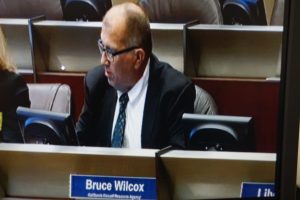
Bruce Wilcox, assistant secretary of the California Natural Resources Agency in charge of Salton Sea Policy, speaks during the California Water Resources Control Board hearing on the Salton Sea today, Nov. 7, in Los Angeles. The State Water Board has voted in favor of a revised order that supports the 2003 Colorado River Quantification Settlement Agreement and sets milestones for the State to meet in addressing restoration at the Sea.
The San Diego County Water Authority today commended the State Water Resources Control Board for setting annual milestones for state restoration activities at the Salton Sea and a Dec. 31, 2022, deadline for the state to deliver long-term Salton Sea restoration plans.
At its meeting in Los Angeles, the State Water Board revised its 2002 order that approved the nation’s largest agriculture-to-urban water transfer between the Water Authority and the Imperial Irrigation District. In doing so, the State Water Board reaffirmed the State of California’s continued support for the transfer, the broader 2003 Colorado River Quantification Settlement Agreement, and the ongoing mitigation program outlined in the QSA.
Today’s action also establishes the State Water Board’s jurisdiction – independent of the water transfer – to ensure state agencies move forward with a restoration program, a responsibility placed on the state by legislation 15 years ago.
The Water Transfer Agreement between the Water Authority and IID is a cornerstone of the QSA and key to the Water Authority’s diversification strategy for ensuring a reliable water supply for the San Diego region. Water transfers started in 2003, helping reduce California’s use of the Colorado River through a water conservation program funded largely by the Water Authority that provided complete mitigation of adverse impacts on the Salton Sea. This year, the San Diego region will receive 100,000 acre-feet of water from the transfers, enough to serve approximately 200,000 typical households.
In 2002, the State Water Board approved the transfer agreement, which included interim water deliveries to the Salton Sea funded by a Joint Powers Authority of which the Water Authority is a member. Those mitigation water deliveries have been effective in offsetting potential impacts of the transfers on Salton Sea water levels for the past 15 years, providing time to enable the state to develop a long-term restoration strategy.
Today’s action by the State Water Board sets the stage for a seamless transition from providing mitigation water to the sea to implementing a robust, multi-pronged air quality program that can work hand-in-hand with the state’s restoration program.
“We applaud the State Water Board for taking this important step to help California meet its commitments to Salton Sea restoration, just as water agencies have made good on their pledge to mitigate the effects of water transfers,” said Water Authority General Manager Maureen Stapleton. “This joint effort promotes the public interest by protecting public health and ensuring the continued delivery of conserved water for the benefit of our region, the state and the entire Colorado River Basin.”
Today’s revised order reflects support from the Water Authority, Imperial Irrigation District, Imperial County and the California Natural Resources Agency, along with environmental organizations. It includes milestones for implementing the first phase of the state’s Salton Sea Management Program – a 10-year series of projects expected to cost $380 million and cover about 30,000 acres of playa to reduce dust emissions and improve habitat. The revised order also declares that a smaller, sustainable Salton Sea is feasible, and that the state will lead and coordinate management efforts. Further, it says the state has the lead role in generating restoration funds.
To date, the state has secured $80 million for the Salton Sea Management Plan through a water bond approved by voters in 2014. A new water and parks bond that includes $200 million for the Salton Sea will go before California voters in June 2018.
While the state is just starting its restoration program, the QSA Joint Powers Authority has consistently met its obligations to provide an environmental mitigation program at the sea. The QSA JPA includes the Water Authority, Imperial Irrigation District, the Coachella Valley Water District, and the state Department of Fish and Wildlife.
State legislation capped the water agencies’ mitigation at $133 million (in 2003 dollars) and required the state to cover mitigation costs that exceed that amount. In addition to delivering mitigation water to the sea for 15 years, the water agencies have placed six air-quality monitoring stations near the sea and implemented air quality pilot projects to identify methods that work best for suppressing dust. When mitigation flows to the sea end in 2018, the JPA will fund a substantial program of air quality projects to address exposed playa related to the QSA that is found to be emissive.
In addition, the three water agencies provided $30 million (in 2003 dollars) as seed money for a separate restoration program that helped fund projects in the state’s management plan that are expected to provide more than 1,000 acres of habitat.
To view the revised order, see the State Water Board’s Salton Sea page at https://www.waterboards.ca.gov/waterrights/water_issues/programs/salton_sea/.
